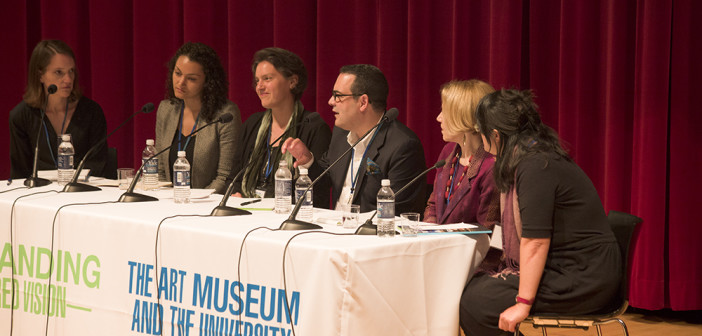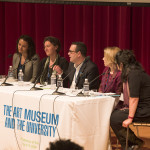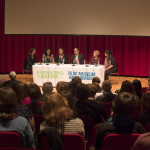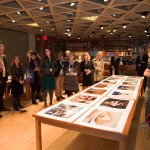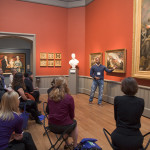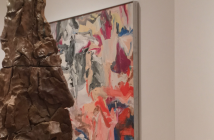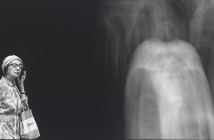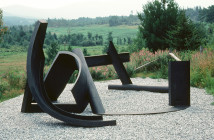 Engaging Audiences panel, May 8, 2014; seated left to right: panel chair Molleen Theodore, Yale University Art Gallery; Tess Korobkin, Yale University Art Gallery; Cyra Levenson, Yale Center for British Art; Luis Croquer, Henry Art Gallery, University of Washington; Marla Berns, Fowler Museum at UCLA; Aimee Chang, Berkeley Art Museum and Pacific Film Archive
Engaging Audiences panel, May 8, 2014; seated left to right: panel chair Molleen Theodore, Yale University Art Gallery; Tess Korobkin, Yale University Art Gallery; Cyra Levenson, Yale Center for British Art; Luis Croquer, Henry Art Gallery, University of Washington; Marla Berns, Fowler Museum at UCLA; Aimee Chang, Berkeley Art Museum and Pacific Film Archive
From May 8-10, a group composed largely of museum professionals convened in New Haven for Expanding a Shared Vision: The Art Museum and the University, a conference held at the Yale Art Gallery. The conference centered on fundamental questions about three elements — audience engagement, teaching and learning with art, and the role of curators — as they relate to academic and university-linked museums. The first day started with a panel on audience engagement, tackling the ever-thorny questions of who museum audiences are, who they will or should be in the future, and how they interact with museums. As I listened to the professionals who made up this panel, I found myself consistently drawing parallels to greater Boston, where the cultural sector is uniquely rooted in academic traditions and connected to educational institutions. In a city where campus life is woven into the urban fabric and the distinction between academic and non-academic networks is frequently blurred, how do university museums both fit into and evolve with their environment?
These questions are particularly relevant as the broader museum community considers its role in a field that moves increasingly toward participatory models of art, engagement, and experience. From Nina Simon’s much-discussed Participatory Museum to the hype around crowdsourcing, the role of the expert is being thoroughly questioned, and the panelists at Yale jumped right into that conversation. As a group, the panelists emphasized the role of public programming and participatory projects in contemporary museum practice, using case studies of projects from their own institutions to frame this discussion. The case studies encompassed various models for community engagement, ranging from the Fowler Museum at UCLA’s work with members of Los Angeles’ Chicano and Iranian Jewish communities on exhibitions about their cultures to the creation of the Test Site, a space for expanded forms of research and idea exchange, at the University of Washington’s Henry Art Gallery. The institutions represented on the panel seemed to be at different places in their incorporation of participatory, shared-authority models into their work, with some institutions carving out specific programs or spaces for these models and others more fully integrating these processes into their collections and curatorial decisions.
Despite these disparities, however, all five panelists framed their work in the language of participatory experience, presenting their museums’ spaces and staff as facilitators for the creation of environments in which surprises, collaborations, and original experiences and idea exchanges could take place. As the Henry Art Gallery’s Luis Croquer noted, part of the impulse for this within the context of his museum, which focuses on contemporary art, is the current turn toward social practice art and museums’ eagerness to engage with this movement. Although the Henry’s Test Site is meant to foster creative research processes through programs and does not use the "artist intervention" model explicitly, the projects, workshops, residencies, and other happenings that shape the space don’t fall far from the big, and often confusing, tent of social practice. While numerous panelists spoke about the role of artists as facilitators and as activators of museum spaces, the Berkeley Art Museum’s Aimee Chang asked whether museums rely on artist interventions to "give themselves permission" to focus on participation and process, challenging museums to transcend that model and to recognize university museums’ potential as labs that provide unique contextualization for the creative process. This current moment — in which the drive toward participation is coming both from artists, whose products are challenging traditional notions of display, and from changing interpretations of mission within cultural institutions themselves — is fascinating, particularly when connected to academic settings.
 Artist and alumnus Titus Kaphar talks about how the Gallery's collection, including John Trumbull's Declaration of Independence, has inspired his own work
Artist and alumnus Titus Kaphar talks about how the Gallery's collection, including John Trumbull's Declaration of Independence, has inspired his own workIn many ways, universities are grappling with similar questions as museums, with educational institutions increasingly seeking to incorporate project-based learning, community collaborations, and a heightened focus on process into their teaching and scholarship. Despite the pushback that continues to challenge some of these efforts, the panelists at Yale highlighted the enthusiasm for increased participation and community engagement they see among academics, pointing to university museums as ideal spaces for experiential learning. Tess Korobkin, a Yale graduate student, noted that many graduate students are interested in expanding the civic impact of museums and the role of the arts and humanities, and that this impulse transcends what some see as the mere trends of social practice and participatory experience.
In making this point, Korobkin drew from Russian theorist Viktor Shklovsky, who argued for the role of art in defamiliarizing concepts and provoking new feelings and ideas. Taken together, the panelists all spoke to this emphasis on defamiliarization, pointing to participatory projects and new forms of audience engagement as ways of defamiliarizing the museum and allowing for new kinds of learning and idea exchange. Seen from this lens, participatory models don’t ignore the expertise and value of traditional experts like curators and professors; rather, they reframe and expand on this expertise, bringing in experts from fields across the museum and university community and putting these experts in conversation with audience members who bring their own expertise to the table.
Ultimately, the impact of these projects comes down to who shows up at the table, and the depth of conversations that take place once they’re there. The panelists acknowledged the challenges of audience engagement, from the skepticism of New Haven public school teachers over the relevance of museums to their students to the Fowler Museum’s difficulty in figuring out how to facilitate cross-pollination between the various Los Angeles communities it works with. This is the primary challenge facing this type of work — there is clear interest in expanded participation on the part of a significant group of artists, museum professionals, and academics, but meaningful participatory experiences require significant preparation. Implicit barriers to entry to museums continue to exist, and university museums face the added challenge of being associated with institutions that can often appear elitist or hidden behind Ivy-covered walls.
In order to truly foster participation, museums must engage deeply with community members, incorporate a range of people from within and beyond the university who bring something to the table, and focus on the synthesis that can come from this work. At their best, participatory projects cultivate the remixing of networks and ideas and promote the creation of something new, not as community service or a ticket-seller, but as collaborative learning. When museums truly integrate products — whether those products are paintings on the walls or a body of scholarship — with process, they can defamiliarize both elements and power real synthesis.
In Boston, I’ve often heard it said that local artists and arts organizations already draw from academic rigor and value the cross-pollination of ideas that universities and similar settings promote. In many ways, there’s already the expectation that museums, in particular, are linked to wide-ranging scholarship, thanks to the presence of museums and galleries based at institutions ranging from MassArt to MIT, the familiar movement of curators between university and non-university museums, the incorporation of lectures by academics into programming at the ICA and elsewhere, and so on. However, while there’s plenty of cross-pollination within the core of these institutions’ audiences, new audience engagement can seem limited, and it’s a common complaint that the greater Boston community tends to think of "art" largely in terms of the masterpieces at the MFA, rather than ongoing productions and processes. Academic museums present a unique entry point for challenging these perceptions. The processes of the university — teaching, research, scholarly production — are dynamic and endlessly interconnected, and university museums provide rare public spaces to see, play with, and contribute to these processes. Ideally, art helps open these interactions by defamiliarizing concepts and sparking ideas that can be built on.
Current experiments in this participatory ethos have yielded mixed results, with some museum projects feeling like pandering to a trend while others have retained a rigorous, critical edge, but experimentation can yield synthesis — in this case, hopefully a synthesis of creative and critical, process and product, and multiple forms of expertise. While the Yale conference provided helpful grounding for this work and pointed to developing questions, models, and approaches in participatory projects for university museums, Boston — with its unique concentration of universities and its frequent intermingling between academic and cultural circles — is an ideal test site for the evolving role of the university museum.
- Engaging Audiences panel, May 8, 2014; seated left to right: panel chair Molleen Theodore, Yale University Art Gallery; Tess Korobkin, Yale University Art Gallery; Cyra Levenson, Yale Center for British Art; Luis Croquer, Henry Art Gallery, University of Washington; Marla Berns, Fowler Museum at UCLA; Aimee Chang, Berkeley Art Museum and Pacific Film Archive
- Engaging Audiences panel, May 8, 2014; seated left to right: panel chair Molleen Theodore, Yale University Art Gallery; Tess Korobkin, Yale University Art Gallery; Cyra Levenson, Yale Center for British Art; Luis Croquer, Henry Art Gallery, University of Washington; Marla Berns, Fowler Museum at UCLA; Aimee Chang, Berkeley Art Museum and Pacific Film Archive
- Artists in residence Jim Goldberg and Donovan Wylie discuss their current photography projects
- Artist and alumnus Titus Kaphar talks about how the Gallery’s collection, including John Trumbull’s Declaration of Independence, has inspired his own work
All photos courtesy of Yale University Art Gallery

